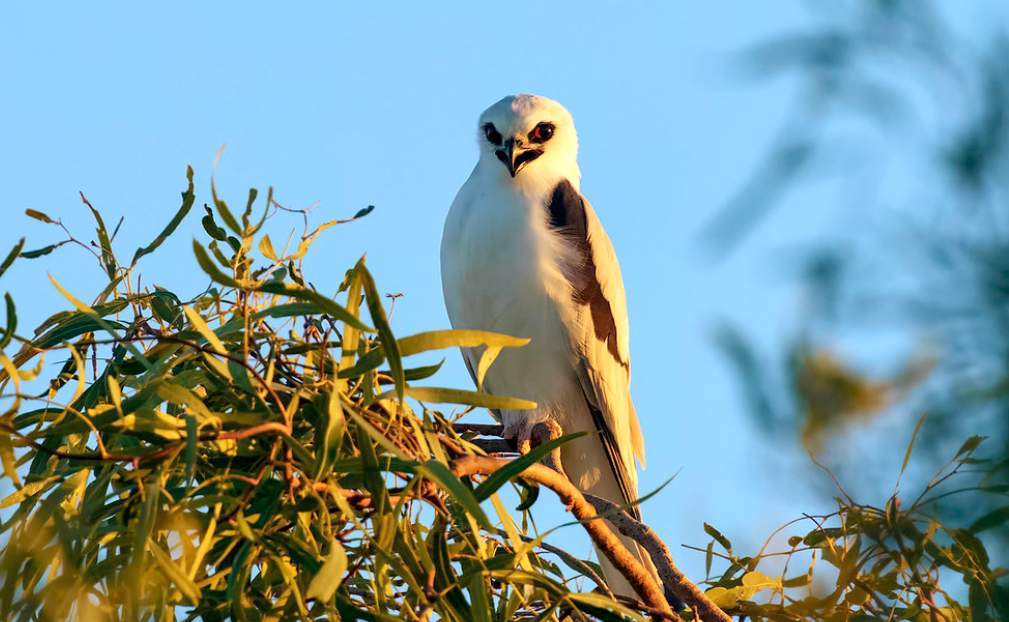Habitats:
‘BOOM-AND-BUST’ controls the rarely seen Letter-winged Kite (Elanus scriptus). During the day, they rest quietly in groups among the leafy branches of trees, sometimes nestling together. They emerge on exposed branches as dusk approaches and become restless. During the night, they fly out alone to hunt.
They glide along the shallow slope quietly and buoyantly, 10-30 meters above ground, with rounder wings than Black-shouldered Kites. A hawk spotting its prey hovers slowly before dropping onto it, talons first and wings stretched high. Upon capture, animals are talons are carried back to a perch to be eaten. Letter-winged Kites nest in colonies that wax and wane with food supply, raising brood after brood for as long as food is available. There is only one season for the pairing.

Food:
Kites rely almost exclusively on native Australian plague rats, Rattus villosissimus. A species of this genus lives in northeastern central Australia, along the river system of the Georgina, Diamantina, and Cooper Creeks. Rat plagues are beneficial to kites during certain seasons, when they breed and thrive. Rodent hordes advance through inland basins as they follow them.
Following the drought, plagues spread, and kite populations plummet. It is common for birds to die. In desert pockets, some hang on to native and marsupial mice, forming the nucleus of the next boom. Other species disperse across the continent where they feed on other rodents, reptiles, and insects, including house mice, Mus musculus. After a crash inland at the end of 1976, almost a hundred of them reached Werribee near Melbourne in early 1977. There were only a few birds left alive by the end of winter.
It is possible that such a large number of kites reach Victoria because of the direction in which rat plagues disperse. It hunts nocturnally, roosts, and breeds in colonies to exploit rats. Until nearly fully grown, females incubate, brood, dismember, and pass food on to the young.
After arriving with prey, when the colony is awakened at night, the male calls to his mate and she flies out with a quivering display of flight to catch it in midair. Letter-winged Kites can recover their numbers rapidly due to the fact that they acquire adult plumage within two-three months of fledging.
Courtship:
The male flies high in courtship, circling his mate on steeply raised, quivering wings. Eventually, they both circle around each other and mate on top of a bare branch in the nest tree, quivering their wings. They both contribute to building the nest each season, or renovating an old one with green leaves and later fur from prey.
Size:
Approximately 345-380 millimeters is the length of the Letter-winged Kite.
Identification:
Females are slightly larger than males; both sexes are similar. A white patch around the eye merges into a light gray patch on the crown. The nape, back, and rump are light to medium grey in color. Round, mid-grey primaries with a broad black shoulder patch. There are pale shafts on the tail and a white tail. Underwing coverts and axillaries are black with white underparts.
The eyes are orange-red, and the skin around the eyes is black. Its bill is black; its cere is green to yellow-grey or horn-colored. Legs are flesh-cream; claws are black. An immature bird has rusty grey-brown coloration from crown to rump, mauled white scapulars and broadly tipped white flight feathers and wing coverts; reduced black shoulders. The breast band is mauled rusty and cream-white in the center. The eyes are brown in color. Cream-white down young are followed by cream-grey; black feet and bill.
Vocals:
When breeding, Letter-winged Kites’ calls are rapid sharp whistles, similar to Black-shouldered Kites, but louder and harsher: Kack-kack-kack, chirp-chirp-chirp; repeated harsh kar; also screeches. Females and young call at nest wee-er, wee-er.
Nesting and breeding:
Breeding is sporadic and opportunistic, continuous when food is abundant; colonial. This nest consists of light sticks and twigs, lining it with leaves and sometimes wool or rodent’s fur; it is placed in an upright fork, in thick foliage, usually one to twelve meters above ground. Three to six eggs; creamy to maul-shaped, speckled and blotched with red-brown, concentrated at the larger end; oval to rounded-oval, about 44 x 32 mm.







